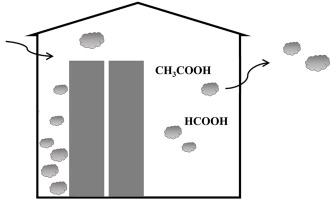当前位置:
X-MOL 学术
›
Build. Environ.
›
论文详情
Our official English website, www.x-mol.net, welcomes your feedback! (Note: you will need to create a separate account there.)
Distribution of temperature, moisture and organic acids in storage facilities with heritage collections
Building and Environment ( IF 7.4 ) Pub Date : 2020-05-01 , DOI: 10.1016/j.buildenv.2020.106782 Signe H. Smedemark , Morten Ryhl-Svendsen , Jørn Toftum
Building and Environment ( IF 7.4 ) Pub Date : 2020-05-01 , DOI: 10.1016/j.buildenv.2020.106782 Signe H. Smedemark , Morten Ryhl-Svendsen , Jørn Toftum

|
Abstract The preservation of heritage collections in storage largely depends on the air quality conditions. Uncontrolled airflow transports unconditioned air into the building. Lowering the air exchange rate in unoccupied storage facilities is therefore essential to ensure acceptable climate conditions for the preservation of collections, while at the same time reducing the energy use for climate control. The concern is, however, that a restricted airflow can create uneven microclimates within a room, with thermal stratification as well as accumulation of indoor generated pollutants, which may accelerate the deterioration of the collections. This paper examines the air distribution within one storage building with a heating, ventilation and air-conditioning (HVAC) system, and in two rooms in another storage with semi-passive climate control. A sensor grid was established in each room in order to map the distribution of temperature, relative humidity (RH) and volatile organic acids determined as the sum of acetic and formic acid concentration. This study demonstrated that both tested ventilation forms upheld an acceptable climate performance with appropriate temperature and moisture distributions and without air pockets producing problematic microclimates. However, organic acids accumulated in concentrations up to 134 μg m−3 in parts of one storage room with semi-passive climate control. Whether to install a HVAC system with gaseous air filtration to remove organic acids will ultimately depend on the threshold level that caretakers are willing to accept.
中文翻译:

具有文物收藏品的储存设施中的温度、水分和有机酸分布
摘要 馆藏文物的保存在很大程度上取决于空气质量状况。不受控制的气流将未经调节的空气输送到建筑物中。因此,降低空置存储设施的空气交换率对于确保收藏品保存可接受的气候条件至关重要,同时减少用于气候控制的能源使用。然而,令人担忧的是,受限的气流会在房间内造成不均匀的小气候,产生热分层以及室内产生的污染物的积累,这可能会加速收藏品的恶化。本文研究了一个带有供暖、通风和空调 (HVAC) 系统的仓库内的空气分布,以及另一个带有半被动气候控制的仓库中两个房间的空气分布。每个房间都建立了一个传感器网格,以绘制温度、相对湿度 (RH) 和挥发性有机酸的分布图,挥发性有机酸确定为乙酸和甲酸浓度的总和。该研究表明,经过测试的两种通风形式均维持了可接受的气候性能,具有适当的温度和湿度分布,并且没有产生问题小气候的气穴。然而,在一个具有半被动气候控制的储藏室的部分区域中,有机酸的积累浓度高达 134 μg m-3。是否安装带有气态空气过滤功能的 HVAC 系统以去除有机酸,最终将取决于管理员愿意接受的阈值水平。相对湿度 (RH) 和挥发性有机酸,确定为乙酸和甲酸浓度的总和。该研究表明,经过测试的两种通风形式均维持了可接受的气候性能,具有适当的温度和湿度分布,并且没有产生问题小气候的气穴。然而,在一个具有半被动气候控制的储藏室的部分区域中,有机酸的积累浓度高达 134 μg m-3。是否安装带有气态空气过滤功能的 HVAC 系统以去除有机酸,最终将取决于管理员愿意接受的阈值水平。相对湿度 (RH) 和挥发性有机酸,确定为乙酸和甲酸浓度的总和。该研究表明,经过测试的两种通风形式均维持了可接受的气候性能,具有适当的温度和湿度分布,并且没有产生问题小气候的气穴。然而,在一个具有半被动气候控制的储藏室的部分区域中,有机酸的积累浓度高达 134 μg m-3。是否安装带有气态空气过滤功能的 HVAC 系统以去除有机酸,最终将取决于管理员愿意接受的阈值水平。该研究表明,经过测试的两种通风形式均维持了可接受的气候性能,具有适当的温度和湿度分布,并且没有产生问题小气候的气穴。然而,在一个具有半被动气候控制的储藏室的部分区域中,有机酸的积累浓度高达 134 μg m-3。是否安装带有气态空气过滤功能的 HVAC 系统以去除有机酸,最终将取决于管理员愿意接受的阈值水平。该研究表明,经过测试的两种通风形式均维持了可接受的气候性能,具有适当的温度和湿度分布,并且没有产生问题小气候的气穴。然而,在一个具有半被动气候控制的储藏室的部分区域中,有机酸的积累浓度高达 134 μg m-3。是否安装带有气态空气过滤功能的 HVAC 系统以去除有机酸,最终将取决于管理员愿意接受的阈值水平。
更新日期:2020-05-01
中文翻译:

具有文物收藏品的储存设施中的温度、水分和有机酸分布
摘要 馆藏文物的保存在很大程度上取决于空气质量状况。不受控制的气流将未经调节的空气输送到建筑物中。因此,降低空置存储设施的空气交换率对于确保收藏品保存可接受的气候条件至关重要,同时减少用于气候控制的能源使用。然而,令人担忧的是,受限的气流会在房间内造成不均匀的小气候,产生热分层以及室内产生的污染物的积累,这可能会加速收藏品的恶化。本文研究了一个带有供暖、通风和空调 (HVAC) 系统的仓库内的空气分布,以及另一个带有半被动气候控制的仓库中两个房间的空气分布。每个房间都建立了一个传感器网格,以绘制温度、相对湿度 (RH) 和挥发性有机酸的分布图,挥发性有机酸确定为乙酸和甲酸浓度的总和。该研究表明,经过测试的两种通风形式均维持了可接受的气候性能,具有适当的温度和湿度分布,并且没有产生问题小气候的气穴。然而,在一个具有半被动气候控制的储藏室的部分区域中,有机酸的积累浓度高达 134 μg m-3。是否安装带有气态空气过滤功能的 HVAC 系统以去除有机酸,最终将取决于管理员愿意接受的阈值水平。相对湿度 (RH) 和挥发性有机酸,确定为乙酸和甲酸浓度的总和。该研究表明,经过测试的两种通风形式均维持了可接受的气候性能,具有适当的温度和湿度分布,并且没有产生问题小气候的气穴。然而,在一个具有半被动气候控制的储藏室的部分区域中,有机酸的积累浓度高达 134 μg m-3。是否安装带有气态空气过滤功能的 HVAC 系统以去除有机酸,最终将取决于管理员愿意接受的阈值水平。相对湿度 (RH) 和挥发性有机酸,确定为乙酸和甲酸浓度的总和。该研究表明,经过测试的两种通风形式均维持了可接受的气候性能,具有适当的温度和湿度分布,并且没有产生问题小气候的气穴。然而,在一个具有半被动气候控制的储藏室的部分区域中,有机酸的积累浓度高达 134 μg m-3。是否安装带有气态空气过滤功能的 HVAC 系统以去除有机酸,最终将取决于管理员愿意接受的阈值水平。该研究表明,经过测试的两种通风形式均维持了可接受的气候性能,具有适当的温度和湿度分布,并且没有产生问题小气候的气穴。然而,在一个具有半被动气候控制的储藏室的部分区域中,有机酸的积累浓度高达 134 μg m-3。是否安装带有气态空气过滤功能的 HVAC 系统以去除有机酸,最终将取决于管理员愿意接受的阈值水平。该研究表明,经过测试的两种通风形式均维持了可接受的气候性能,具有适当的温度和湿度分布,并且没有产生问题小气候的气穴。然而,在一个具有半被动气候控制的储藏室的部分区域中,有机酸的积累浓度高达 134 μg m-3。是否安装带有气态空气过滤功能的 HVAC 系统以去除有机酸,最终将取决于管理员愿意接受的阈值水平。



























 京公网安备 11010802027423号
京公网安备 11010802027423号